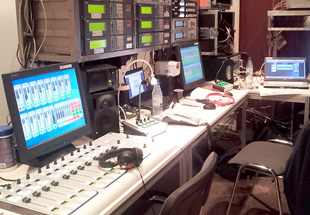As well as130,000 faithful, the closing event of the recent Evangelischer Kirchentag (Protestant church convention) attracted considerable interest from the German media. With such a heavy demand, the Kirchentag’s biblical motto, ‘As Much as You Need’, applied equally to the technical infrastructure in the event’s press centre, where reporters from around 40 radio stations had access to the feeds at all times.
 The set-up at the 400m² centre in Hamburg was operated by local public broadcaster NDR (North German broadcaster), and provided the various ARD stations (Germany’s public broadcasters) with separate cubicles for their editorial staff. In addition to these workplaces, there were two self-op studios, three studios with sound engineers and one central control room. Outside, several radio stations had also brought in OB trucks that needed additional access to the audio feeds.
The set-up at the 400m² centre in Hamburg was operated by local public broadcaster NDR (North German broadcaster), and provided the various ARD stations (Germany’s public broadcasters) with separate cubicles for their editorial staff. In addition to these workplaces, there were two self-op studios, three studios with sound engineers and one central control room. Outside, several radio stations had also brought in OB trucks that needed additional access to the audio feeds.
These vehicles were linked via fibre-optic cables configured as three VLANs (Virtual LANs) – the first connected the OB vans with the internal ARD network, the second established a general internet connection, and the third was used for Ravenna streams to transport the audio. QoS (Quality of Service) was assigned to the network to guarantee sufficient bandwidth – but, as it turned out, the network requirements were sufficiently low that there were no problems.
The journalists in the OB vans also had their own monitoring in the form of an Axia xNode that could receive eight channels and connect to the Ravenna stream, and a Lawo KS-16 connected via Ethernet to select the required audio. The KS-16 controlled a Lawo crystal console in the master control room, which then supplied a selection of eight channels via the Ravenna network.
Part of the appeal of using Ravenna was that it is a non-proprietary technology based on Ethernet: ‘Because of the Layer-3 technology, we were able to use existing network structures. We wouldn’t have gained anything by laboriously installing new cabling – the use of the existing structure meant that we were able to reduce the effort significantly,’ explains Sascha Schwoll, responsible for outside broadcast at German public broadcaster SWR and part of the ARD-team that planned and implemented the technical setup at the Kirchentag.
Nine Lawo crystal consoles were used for the event – two 4-fader desks in the self-op studios, three 8-fader desks in the studios, and a 12-fader desk in the central control room. Additionally, there were three crystal base units without control panels, which were used to switch signals. Central audio administration was managed by a Lawo Nova29 router and VisTool touchscreen software. Up to 12 events were simultaneously transmitted to the press centre, plus additional streams with news, meaning that 16 signals had to be available to the journalists in the cubicles and OB vans, who had to be able to access any of the signals as required.
Broadcasters at the event were able to book time slots in the self-op studios, for example to record interviews and send them to their stations via file transfer, or to conduct a live interview. There were several prominent interview partners in Hamburg that were provided with headsets by the sound engineers or editorial staff in the self-op studios, and then connected – as with WDR in Cologne. WDR then would either broadcast the interview live, or record it for later transmission.
In their workplaces, journalists also had small monitor speakers and a Lawo KS-16 module to select the audio signal they required. To make this set-up manageable, the editorial workplaces were combined in groups of five-to-six cubicles, each taking audio from a crystal base unit. These base units received their signals from the Nova29 router in the master control room.
With the Kirchentag as a trial operation, Ravenna may find use for similar future events: ‘It is planned that the editorial journalists simply select the Ravenna streams they need to listen to on their laptops,’ Schwoll says. ‘Besides supplying individual journalists with audio streams, I’m thinking about setting up an ARD-wide multicast that, in the future, would contribute the signals across all connected stations.’
The Frankfurt Book Fair (Buchmesse), set to take place in October, will also use NDR’s Lawo sapphire consoles, and broadcasters’ laptops will again be networked via Ravenna streams. This was one of the reasons for the use of Lawo solutions. ‘Because Lawo is so widely used at all the big events, it makes a lot of sense for us to work with them also on smaller radio broadcast events, Schwoll says. ‘The only difference is that the number of available channels is not of highest priority. Much more important to us in this context is to be able to use existing network structures with Ravenna.’
More: www.lawo.de















